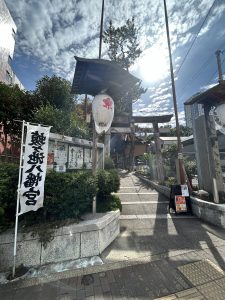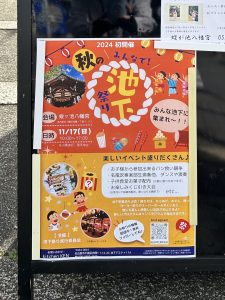秋祭りの季節です(愛知県名古屋市千種区姫池通 骨董買取 古美術風光舎)
2024.10.22
皆さまこんにちは。スタッフHでございます。
朝から気持ちの良いお天気で、歩いているだけで気分が晴れやかになります。
先週末、家の外からワッショイワッショイと元気な声が聞こえてきたのでベランダから覗いてみると、法被にはちまき姿の子供たちが神輿(みこし)を担いで歩いておりました。子供たちを鼓舞するべく大人も声を張り上げ、微笑ましい光景でした。後で知ったのですが、神輿は上からのぞき見てはいけないそうですね。大変失礼いたしました。
ゆらゆらと担がれている神輿を見ながらふと疑問が湧いてまいりました。神輿と山車(だし)は何が違うんだっけ?この年齢になっても知らないことばかりです。
調べてみますと、決定的な違いは中に「神様を乗せているかいないか」だそうです。神様は普段は神社に鎮座していらっしゃいますが、祭りの際には神輿に乗り、氏子たちに担がれて村や町をまわります。地域にもたらされる厄を祓い、豊作を願い、地域の安寧を見守りながらご神徳を与えてまわります。
それでは山車はといいますと、”神様に降りてきてもらうための目印”だそうです。古来より神は山頂の木や岩を依り代として天から降臨するとされています。それ故、ここが祭場ですと示すために目立つように高く華やかに作られています。京都の祇園祭で毎年先頭を行く長刀鉾があんなに高くそびえているのは目印の役目があるからなのですね。
また山車は内部に人が乗ってお囃子などで神霊をもてなすことができます。そのため時代と共により華やかに、大きくなっていきました。地域ごとに様々な進化を遂げ、「曳山(ひきやま)」「鉾(ほこ)」「屋台(やたい)」「地車(だんじり)」「ねぶた」などと呼ばれるようになっていきます。
もう一つの違いは移動の仕方です。神輿は人が担いで上下に振ります。先日の子供たちもワッショイの掛け声とともに一生懸命に上下に揺さぶっておりました。神様が中にいるのに激しく振ってもいいものかと心配になりますが、この揺さぶる行為は霊魂の活動力を強くする神道の呪術でもあるらしく、古来より存在する神聖な行為なのだとか。神輿を激しく振ることによって、ご神威がより活性化されるそうです。お祭りの光景を何気なく眺めておりましたが、深く知ると見える景色も変わってきそうです。
いっぽう山車の移動は「引き回す」「練り歩く」と表現されます。
山車の原型は平安中期の祇園祭の起源である「祇園御霊会」に遡ります。祟り神を鎮めるために行われた神事で、祟り神の依り代として「山」をかたどった作り物を海や川に流すことで災いを逃れようとしました。
室町時代には祭りは貴族や武家だけではなく、庶民も参加するようになっていきます。当時の乗り物といえば二輪の牛車で、バランスを取るのが難しく左右にゆらゆらと揺れながら進む様子を「ねりねり」と言い表していました。それが「練り歩く」という言葉の語源と言われています。
現在の山車は四輪が主流ですが、昔は二輪しかなく「ねりねり」揺れながら引き回していたとのこと。
時代とともに山車の車輪が二輪から三輪、四輪と増えることで山車の大型化が可能になり、装飾も華やかになっていきます。
しかし4輪になったことで車輪の向きを容易に変えられないというデメリットも生まれ、大きくなった山車のコーナリングは力と技が必要となっていきます。岸和田だんじり祭でも見られる、スピードを落とさず走りながらだんじりを直角に回す「やりまわし」などは、それ自体が山車の最大の見せ場にもなっていますね。
秋は各地でお祭りが催され賑やかになりますが、年々地域のつながりが薄れ継承が途絶えてしまう行事も多いそうです。
先日通りかかりました蝮ケ池八幡宮。お祭りの案内が出ておりまして、なんと「池下祭り」は第1回目の開催となるようです。これから新しく始まるお祭り。なんだかわくわくしますね。


それでは、また次の機会に。
Hello everyone. This is Staff H.
The weather has been pleasant since this morning, and just walking around the house makes me feel refreshed.
Last weekend, I heard cheerful voices outside my house and peeked over the balcony to see children dressed in happi coats and hachimaki (headband) walking around carrying a mikoshi (portable shrine). It was a funny scene, with the adults shouting to inspire the children. I learned later that you are not allowed to peek at the mikoshi from above. I was very sorry.
As I watched the mikoshi being carried on the ground, a question came to my mind. What is the difference between a portable shrine and a float? Even at my age, I still don’t know.
I found out that the decisive difference is whether or not there is a god inside the mikoshi. God usually resides in a shrine, but during festivals, he is carried around the village or town by the shrine parishioners on a portable shrine. The mikoshi is carried around the village or town by the local shrine parishioners to purify the community of evil spirits, to wish for a bountiful harvest, and to watch over the peace and prosperity of the community.
The floats, then, are said to be “landmarks for the gods to come down. Since ancient times, it has been believed that the gods descend from the heavens using the trees and rocks on the top of the mountain as their dependents. Therefore, the tower is made to stand out prominently and gorgeously to indicate that this is the place of the festival. This is why the naginohoko, which leads the way every year at the Gion Festival in Kyoto, rises so high to serve as a landmark.
The floats are also used to entertain the spirits of the gods with musical performances and other entertainment. Therefore, floats have become more colorful and larger with the times. Each region has evolved its own version, and they are called “hikiyama,” “hoko,” “yatai,” “danjiri,” “nebuta,” and so on.
Another difference is the way it is moved. The mikoshi is carried by a person and swung up and down. The other day, the children were shaking the mikoshi up and down with all their might while shouting “wasshoi! It may seem a little worrisome to shake the mikoshi vigorously when there is a god inside, but this shaking is said to be a Shinto ritual that strengthens the active power of the spirit, and is a sacred act that has existed since ancient times. It is said that by shaking the mikoshi violently, the divine power is activated. I used to watch the festival without thinking about it, but I think my view of the festival will change if I learn more about it.
The movement of the floats is described as “pulling around” or “parading around.
The prototype of floats dates back to the “Gion Goryokai,” the origin of the Gion Festival in the mid-Heian period. It was a ritual held to appease a possessed god, and people tried to escape misfortune by throwing a made-up object in the shape of a “mountain” into the sea or a river as a vessel for the possessed god.
In the Muromachi period (1333-1573), the festival was not limited to aristocrats and warriors, but common people also began to participate. The vehicles of the time were two-wheeled oxcarts, which were difficult to balance and swayed from side to side as they moved forward, which was referred to as “neri-neri. This is said to be the origin of the word “neri-neri” (“parade”).
Today, most floats have four wheels, but in the old days, floats had only two wheels and were pulled around while swaying “neri-neri-neri.
As time went by, the number of wheels on floats increased from two to three and then to four, making it possible to make floats larger and more ornately decorated.
However, the four-wheeled floats had the disadvantage that the direction of the wheels could not be easily changed, and the cornering of the larger floats required more strength and skill. The “yarimawashi,” or turning the floats at right angles while running without slowing down, which can be seen at the Kishiwada Danjiri Festival, is in itself the biggest showcase of the floats.
Autumn is a time of festivals and festivities in many parts of Japan, but it is said that many of these events are lost over the years as the ties between communities fade away.
The other day, I passed by Mamushigaike Hachimangu Shrine. The other day, I passed by the Mamushigaike Hachimangu Shrine and saw an announcement of a festival, the first of its kind. A new festival is about to begin. It’s kind of exciting, isn’t it?
See you next time.
*******************
ご実家の整理やお片付けなどをされている方のご相談などが多くございます。
お片付けなどくれぐれもご無理のないようになさってくださいませ。
風光舎では古美術品や骨董品の他にも絵画や宝石、趣味のお品など様々なジャンルのものを買受しております。
お片付けをされていて、こういうものでもいいのかしらと迷われているものでも、どうぞお気軽にご相談下さいませ。
また風光舎は、出張買取も強化しております。ご近所はもちろん、愛知県内、岐阜県、三重県その他の県へも出張いたします。
まずは、お電話お待ちしております。
愛知県名古屋市千種区姫池通
骨董 買取【古美術 風光舎 名古屋店】
TEL052(734)8444
10:00-17:00 OPEN
#出張買取#骨董#古美術#骨董品#絵画#版画#茶道具#刀剣#彫刻

